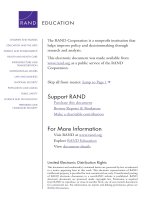Slide OB 13e chapter 012 basic approaches to leadership
Bạn đang xem bản rút gọn của tài liệu. Xem và tải ngay bản đầy đủ của tài liệu tại đây (109.44 KB, 20 trang )
Robbins & Judge
Organizational Behavior
13th Edition
Chapter 12: Basic Approaches to
Leadership
Student Study Slideshow
Bob Stretch
Southwestern College
© 2009 Prentice-Hall Inc. All rights reserved.
12-1
Chapter Objectives
• After studying this chapter, you should be able to:
– Define leadership and contrast leadership and management.
– Summarize the conclusions of trait theories.
– Identify the central tenets and main limitations of behavioral
theories.
– Assess contingency theories of leadership by their level of
support.
– Contrast the interactive theories (path-goal and leader-member
exchange).
– Identify the situational variables in the leader-participation
model.
– Show how U.S. managers might need to adjust their leadership
approaches in Brazil, France, Egypt, and China.
© 2009 Prentice-Hall Inc. All rights reserved.
12-2
What Is Leadership?
• Leadership
– The ability to influence a group toward the
achievement of goals
• Management
– Use of authority inherent in designated formal
rank to obtain compliance from organizational
members
• Both are necessary for organizational success
© 2009 Prentice-Hall Inc. All rights reserved.
12-3
Trait Theories of Leadership
• Theories that consider personality, social, physical, or
intellectual traits to differentiate leaders from
nonleaders
• Not very useful until matched with the Big Five
Personality Framework
• Leadership Traits
–
–
–
–
Extroversion
Conscientiousness
Openness
Emotional Intelligence (Qualified)
• Traits can predict leadership, but they are better at
predicting leader emergence than effectiveness
© 2009 Prentice-Hall Inc. All rights reserved.
12-4
Behavioral Theories of Leadership
• Theories proposing that specific behaviors
differentiate leaders from nonleaders
• Differences between theories of leadership:
– Trait theory: leadership is inherent, so we must
identify the leader based on his or her traits
– Behavioral theory: leadership is a skill set and can
be taught to anyone, so we must identify the
proper behaviors to teach potential leaders
© 2009 Prentice-Hall Inc. All rights reserved.
12-5
Important Behavioral Studies
• Ohio State University
– Found two key dimensions of leader behavior:
• Initiating structure – the defining and structuring of roles
• Consideration – job relationships that reflect trust and respect
• Both are important
• University of Michigan
– Also found two key dimensions of leader behavior:
• Employee-oriented – emphasize interpersonal relationships and is
the most powerful dimension
• Production-oriented – emphasize the technical aspects of the job
– The dimensions of the two studies are very similar
© 2009 Prentice-Hall Inc. All rights reserved.
12-6
Blake and Mouton’s Managerial Grid®
• Draws on both studies to assess leadership style
– “Concern for People” is Consideration and
Employee-Orientation
– “Concern for Production” is Initiating Structure
and Production-Orientation
• Style is determined by position on the graph
Exhibit 12-1
© 2009 Prentice-Hall Inc. All rights reserved.
12-7
Contingency Theories
• While trait and behavior theories do help us
understand leadership, an important component
is missing: the environment in which the leader
exists.
• Contingency Theory deals with this additional
aspect of leadership effectiveness studies.
• Three key theories:
– Fielder’s Model
– Hersey and Blanchard’s Situational Leadership Theory
– Path-Goal Theory
© 2009 Prentice-Hall Inc. All rights reserved.
12-8
Fiedler Model
• Effective group performance depends on the proper match
between leadership style and the situation
– Assumes that leadership style (based on orientation revealed in
LPC questionnaire) is fixed
• Considers Three Situational Factors:
– Leader-member relations: degree of confidence and trust in the
leader
– Task structure: degree of structure in the jobs
– Position power: leader’s ability to hire, fire, and reward
• For effective leadership: must change to a leader who fits
the situation or change the situational variables to fit the
current leader
Exhibit 12-2
© 2009 Prentice-Hall Inc. All rights reserved.
12-9
Assessment of Fiedler’s Model
• Positives:
– Considerable evidence supports the model,
especially if the original eight situations are
grouped into three
• Problems:
– The logic behind the LPC scale is not well
understood
– LPC scores are not stable
– Contingency variables are complex and hard to
determine
© 2009 Prentice-Hall Inc. All rights reserved.
12-10
Fiedler’s Cognitive Resource Theory
• A refinement of Fielder’s original model:
– Focuses on stress as the enemy of rationality and
creator of unfavorable conditions
– A leader’s intelligence and experience influence
his or her reaction to that stress
• Stress Levels:
– Low Stress: Intellectual abilities are effective
– High Stress: Leader experiences are effective
• Research is supporting the theory
© 2009 Prentice-Hall Inc. All rights reserved.
12-11
Hersey & Blanchard’s Situational
Leadership
• A model that focuses on follower “readiness”
– Followers can accept or reject the leader
– Effectiveness depends on the followers’ response to the leader’s
actions
– “Readiness” is the extent to which people have the ability and
willingness to accomplish a specific task
• A paternal model:
– As the child matures, the adult releases more and more control
over the situation
– As the workers become more ready, the leader becomes more
laissez-faire
• An intuitive model that does not get much support from
the research findings
© 2009 Prentice-Hall Inc. All rights reserved.
12-12
House’s Path-Goal Theory
• Builds from the Ohio State studies and the expectancy
theory of motivation
• The Theory:
– Leaders provide followers with information, support, and
resources to help them achieve their goals
– Leaders help clarify the “path” to the worker’s goals
– Leaders can display multiple leadership types
• Four types of leaders:
–
–
–
–
Directive: focuses on the work to be done
Supportive: focuses on the well-being of the worker
Participative: consults with employees in decision-making
Achievement-Oriented: sets challenging goals
© 2009 Prentice-Hall Inc. All rights reserved.
12-13
Path-Goal Model
• Two classes of contingency variables:
– Environmental are outside of employee control
– Subordinate factors are internal to employee
• Mixed support in the research findings
Exhibit 12-4
© 2009 Prentice-Hall Inc. All rights reserved.
12-14
Leader-Member Exchange (LMX)
Theory
• A response to the failing of contingency theories to
account for followers and heterogeneous leadership
approaches to individual workers
• LMX Premise:
– Because of time pressures, leaders form a special
relationship with a small group of followers: the “in-group”
– This in-group is trusted and gets more time and attention
from the leader (more “exchanges”)
– All other followers are in the “out-group” and get less of
the leader’s attention and tend to have formal
relationships with the leader (fewer “exchanges”)
– Leaders pick group members early in the relationship
© 2009 Prentice-Hall Inc. All rights reserved.
12-15
LMX Model
• How groups are assigned is unclear
– Follower characteristics determine group
membership
• Leaders control by keeping favorites close
• Research has been generally supportive
Exhibit 12-3
© 2009 Prentice-Hall Inc. All rights reserved.
12-16
Yroom & Yetton’s Leader-Participation
Model
• How a leader makes decisions is as important as what is
decided
• Premise:
– Leader behaviors must adjust to reflect task structure
– “Normative” model: tells leaders how participative to be in
their decision-making of a decision tree
• Five leadership styles
• Twelve contingency variables
• Research testing for both original and modified models
has not been encouraging
– Model is overly complex
© 2009 Prentice-Hall Inc. All rights reserved.
Exhibit 12-5
12-17
Global Implications
• These leadership theories are primarily studied in
English-speaking countries
• GLOBE does have some country-specific insights
– Brazilian teams prefer leaders who are high in
consideration, participative, and have high LPC scores
– French workers want a leader who is high on initiating
structure and task-oriented
– Egyptian employees value team-oriented, participative
leadership while keeping a high-power distance
– Chinese workers may favor a moderately participative style
• Leaders should take culture into account
© 2009 Prentice-Hall Inc. All rights reserved.
12-18
Summary and Managerial Implications
• Leadership is central to understanding group
behavior as the leader provides the direction
• Extroversion, conscientiousness, and openness all
show consistent relationships to leadership
• Behavioral approaches have narrowed leadership
down into two usable dimensions
• Need to take into account the situational
variables, especially the impact of followers
© 2009 Prentice-Hall Inc. All rights reserved.
12-19
All rights reserved. No part of this publication may be
reproduced, stored in a retrieval system, or transmitted, in
any form or by any means, electronic, mechanical,
photocopying, recording, or otherwise, without the prior
written permission of the publisher. Printed in the United
States of America.
Copyright ©2009 Pearson Education, Inc. Publishing as
Prentice Hall









